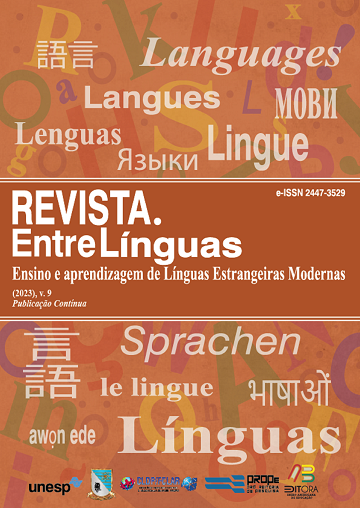Interações da linguagem e da matemática
Cesaro – como somatória para certas séries divergentes
DOI:
https://doi.org/10.29051/el.v9i00.17895Palavras-chave:
Linguagem, Matemática, Polinômios eulerianos, Relação de recorrência, Cesaro – como somaResumo
A matemática tem sua linguagem especial, incluindo gramática e símbolos compartilhados por matemáticos universalmente, independentemente de sua língua materna. Como a matemática é a mesma em todo o mundo, ela pode servir como uma linguagem global. A ideia de atribuir certos valores finitos específicos a determinadas séries divergentes é chamada de Soma de Cesaro. Este artigo tenta analisar a interação entre matemática e linguagem, considerando Cesaro – como soma para certas séries divergentes. Para atingir esse objetivo, polinômios eulerianos são utilizados. Além disso, um novo método de determinação de valores de soma de Cesaro integrando funções geradoras particulares é definido sobre os intervalos fechados e limitados para uma série de potência infinita geral cujos coeficientes são milésimas potências de números naturais. As respostas obtidas fornecem novos insights sobre a compreensão do processo de soma de Cesaro e oferecem uma grande generalização e também revelam a misteriosa interação da matemática e da linguagem.
Downloads
Referências
BLUMS, A. et al. Building links between early socioeconomic status, cognitive ability, and math and science achievement. Journal of Cognition and Development, v. 18, n. 1, p. 16-40, 2017.
GENLOTT, A. A.; GRÖNLUND, Å. Closing the gaps–Improving literacy and mathematics by ict-enhanced collaboration. Computers & Education, n. 99, p. 68-80, 2016.
HOFMANN, R.; MERCER, N. Teacher interventions in small group work in secondary mathematics and science lessons. Language and education, v. 30, n. 5, p. 400-416, 2016.
LEHRL, S. et al. Long-term and domain-specific relations between the early years home learning environment and students’ academic outcomes in secondary school. School Effectiveness and School Improvement, v. 31, n. 1, p. 102-124, 2020.
LEYVA, D. et al. Teacher–child interactions in Chile and their associations with prekindergarten outcomes. Child development, v. 86, n. 3, p. 781-799, 2015.
MARTIN, D. P.; RIMM-KAUFMAN, S. E. Do student self-efficacy and teacher-student interaction quality contribute to emotional and social engagement in fifth grade math?. Journal of school psychology, v. 53, n. 5, p. 359-373, 2015.
PENG, P. et al. Examining the mutual relations between language and mathematics: A meta-analysis. Psychological Bulletin, v. 146, n. 7, p. 595, 2020.
PURPURA, D. J.; REID, E. E. Mathematics and language: Individual and group differences in mathematical language skills in young children. Early Childhood Research Quarterly, v. 36, p. 259-268, 2016.
REDISH, E. F.; KUO, E. Language of physics, language of math: Disciplinary culture and dynamic epistemology. Science & Education, v. 24, n. 5, p. 561-590, 2015.
RIMM-KAUFMAN, S. E. et al. To what extent do teacher–student interaction quality and student gender contribute to fifth graders’ engagement in mathematics learning?. Journal of Educational Psychology, v. 107, n. 1, p. 170, 2015.
ULATOWSKI, F. et al. Recognizing the limited applicability of Job plots in studying host–guest interactions in supramolecular chemistry. The Journal of organic chemistry, v. 81, n. 5, p. 1746-1756, 2016.
Downloads
Publicado
Como Citar
Edição
Seção
Licença

Este trabalho está licenciado sob uma licença Creative Commons Attribution-NonCommercial-ShareAlike 4.0 International License.
Os manuscritos aceitos e publicados são de propriedade da Revista EntreLínguas. Os artigos publicados e as referências citadas na Revista EntreLínguas são de inteira responsabilidade de seus autores.
Transferência de direitos autorais – autorização para publicação
Caso o artigo submetido seja aprovado para publicação, já fica acordado que o(s) autor(es) autoriza(m) a UNESP a reproduzi-lo e publicá-lo na EntreLínguas, entendendo-se os termos “reprodução” e “publicação” conforme definição respectivamente dos incisos VI e I do artigo 5° da Lei 9610/98. O artigo poderá ser acessado pela rede mundial de computadores (Internet), sendo permitidas, a título gratuito, a consulta e a reprodução de exemplar do artigo para uso próprio de quem a consulta, desde que haja a citação ao texto consultado. Essa autorização de publicação 328 EntreLínguas, Araraquara, v. 1, n .2, p. 323-328, jul./dez. 2015 não tem limitação de tempo, ficando a UNESP responsável pela manutenção da identificação do(s) autor(es) do artigo. Os artigos publicados e as referências citadas na Revista EntreLínguas são de inteira responsabilidade de seus autores.











